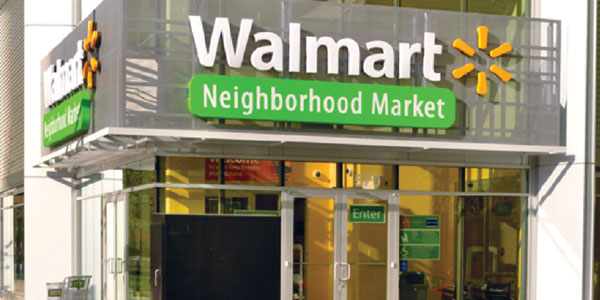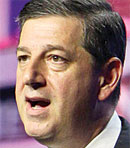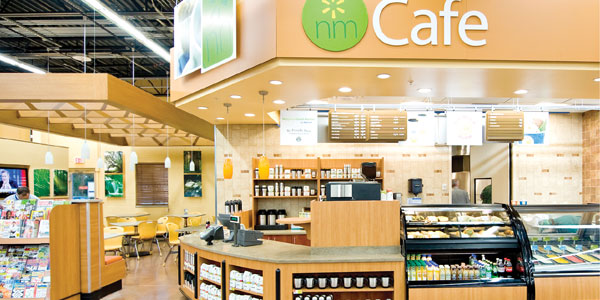As Wal-Mart Stores continues to resolve the challenges of its small-format stores, the rapid proliferation of its Neighborhood Markets and Walmart Express may be close at hand, industry observers told SN.
The rollout of 500 to 1,000 Neighborhood Markets could already be under way, they said, while Wal-Mart contemplates clustering multiple Express stores in a single market to test their compatibility with competitors and the chain’s other formats.
 Wal-Mart already operates approximately 200 Neighborhood Markets — stores of 40,000 to 45,000 square feet with a basic grocery assortment of 35,000 items but no service departments. While the format has been primarily geared to rural locations for the past few years, the company now views Neighborhood Markets as a way into more urban sites.
Wal-Mart already operates approximately 200 Neighborhood Markets — stores of 40,000 to 45,000 square feet with a basic grocery assortment of 35,000 items but no service departments. While the format has been primarily geared to rural locations for the past few years, the company now views Neighborhood Markets as a way into more urban sites.
The company has only 12 Express stores — five of them in Chicago, the others in mostly rural areas — all of which opened in the past 18 months. Stores run 10,000 to 15,000 square feet and offer an assortment of 14,000 basic groceries and convenience items, usually with a pharmacy.
Bryan Gildenberg, chief knowledge officer for Kantar Retail, Cambridge, Mass., said he believes Wal-Mart still faces challenges with the two small formats.
“The idea of getting fresh foods to an urban consumer in a format that’s compelling and cost-effective is a good one, but some observers question whether that SKU count in that small a space at those price points will allow Wal-Mart to make money in the long term.
“However, no one who has ever competed with Wal-Mart says you can ignore Wal-Mart, though it still has a lot to learn about exactly how to construct a value proposition that works in [an] urban environment.
“But the company is going into [these formats] with its eyes wide open and knowing it may have to retool.”
See for Yourself: Wal-Mart Is Back on Track
According to Jim Hertel, managing partner at Willard Bishop, Barrington, Ill., “The growth of small formats for Wal-Mart has a lot to do with the availability of real estate and finding white space that won’t cannibalize existing stores.
“Wal-Mart wants these small formats to work because of the opportunities they present — not because they are small but because of the value equation they offer consumers: Having a Wal-Mart close by that makes for a more convenient shopping experience.
“Consumers aren’t really looking for small stores. They are drawn to these stores because they need to save money and these stores are priced attractively.”
 As far as Bill Simon (right), president of Walmart U.S., is concerned, the company has been extremely satisfied with the Express format, telling investors last month the stores’ performance has been a pleasant surprise.
As far as Bill Simon (right), president of Walmart U.S., is concerned, the company has been extremely satisfied with the Express format, telling investors last month the stores’ performance has been a pleasant surprise.
“What we’re trying to do is proof the top line, and what we’re finding is that, inside of 12 months, these stores are actually delivering a positive bottom line as well. So we’re very optimistic,” he said.
“It’s a bit unique in our experience — as well as in the experience of others who have been trying to deal with a small-format entry — that these stores are turning profitable inside of 12 months. We didn’t actually project that. We didn’t even try to engineer that. Now we’re into the refining stage instead of the re-jiggering stage.”
'Encouraging' Express Response
Nathan Rich, an analyst with Citicorp, New York, echoed Simon’s optimism about the Express format, noting that the early customer response has been “encouraging,” with six more Express stores scheduled to open this year and approximately 20 more set for 2013.
Simon said Wal-Mart contemplates moving ahead rapidly with Express locations, noting that at the peak of supercenter expansion, the company opened 350 supercenters in a single year, “and I think we have the ability to open a like number [of Express stores], if we can determine if the market would absorb them,” he said. “That’s what we’re trying to understand — how many it would take and what impact it would have on the marketplace.
“We’re going to work on density — how many [Express stores] can you build in a market? In the back half of this year you’ll see us go to market and build them out very densely so we can understand their interaction with the rest of the market, including our own stores.”
Hertel said he would expect Wal-Mart to pursue Express openings in major metropolitan areas, mostly in the East, “where there are a lot of incremental sales opportunities” — places like New York, Boston or other cities where it’s been unable to open supercenters because of lack of real estate or local resistance, he noted.
Wal-Mart Pursues Multichannel Expansion
Regarding the prospects for Express stores in rural areas, Gildenberg said, “That’s a more direct attempt by Wal-Mart to mitigate the impact of dollar stores — to figure out how to keep itself insulated in rural America, which is one of its obvious strengths — while figuring out how to get that format to make money at those price points.”
Whether for urban or rural locations, the logistics and distribution could still pose some challenges, Gildenberg said. “How does Wal-Mart take its existing distribution infrastructure and apply all its skills and scale to a store with materially less volume than a supercenter?
“If Wal-Mart can crack the code on that over the next couple of years, it could get very aggressive on smaller formats in rural areas to give shoppers there the same value it delivers in other formats.”
Wal-Mart Is Leveraging Global Presence
Simon talked about distribution initiatives in his investor presentation. “We believe there’s an opportunity for us to do some really innovative things on the supply-chain side,” he said.
“For example, imagine if you can get to a market density where a trailer drops off product to a supercenter and then a small truck runs the route of nearby Express stores, so you almost use a supercenter as a cross-dock opportunity to deliver to the smaller stores.
“That’s kind of the mentality and the mindset that we’re into as we look to refine the Express stores.”
Filling Between Supercenters
Wal-Mart began opening Neighborhood Markets in 1998 but delayed a rapid rollout “[because] we had great growth opportunities with supercenters that gave us a bigger bang for the buck,” Charles M. Holley, Jr., executive vice president and chief financial officer, said earlier this year.
But now that supercenters have pretty much saturated many markets, Wal-Mart is counting on Neighborhood Markets to fill in some of the spaces in between, particularly in urban markets.
 Neil Stern, senior partner at McMillan Doolittle, Chicago, said Neighborhood Markets are “good, functional supermarkets” at this point in their development. “It’s a very credible supermarket with strong pricing where consumers can do their full center-store and perishables shopping and save money.
Neil Stern, senior partner at McMillan Doolittle, Chicago, said Neighborhood Markets are “good, functional supermarkets” at this point in their development. “It’s a very credible supermarket with strong pricing where consumers can do their full center-store and perishables shopping and save money.
“In addition, Wal-Mart has gotten the perishables assortment right and figured out how to meet customers’ needs in a smaller box.
“Neighborhood Markets are basically cookie-cutter stores in terms of size and layout, but where the difference comes is in the assortment, which includes local brands and products geared to specific demographics.
“What the stores are not doing is going after assortment and variety, high service levels or foodservice offerings — areas many conventional supermarket operators are investing in and areas Wal-Mart has played around with over the years,” Stern said.
Price Comparisons, EDLP Drive Wal-Mart's U.S. Sales Growth
Simon said he’s optimistic about the future of Neighborhood Markets, noting that Wal-Mart opened six in the first quarter of 2012 — primarily in established markets like Florida, Texas and Oklahoma — with plans to open 16 more by the end of July in some new markets, including the first Neighborhood Markets on the West Coast — in West Linn, Ore., near Portland, and in Panorama City, near Los Angeles.
With 81 Neighborhood Markets scheduled to open by the end of this year, “we’ll be adding [nearly] 50% to the [200-store] fleet, and a very robust pipeline exists going forward,” Simon said.
Rich of Citicorp pegged the number of potential sites in the pipeline at more than 180.
See for Yourself: Wal-Mart Is Back on Track
He also said the format has experienced five consecutive quarters of positive comp sales and traffic growth, “and returns have improved significantly, approaching those of a supercenter.”
Acknowledging the strong returns and comp-store results, Simon said, “The thing that makes Neighborhood Markets really cool is that we can leverage general merchandise sales through the site-to-store capabilities we have. So you can do your grocery shopping there, but if you want a television or a futon, you can go to walmart.com and have it sent to the store so you can pick it up the next time you are there.”
According to Gildenberg, what traditional supermarkets should look for in Neighborhood Markets “is how they operate, especially in terms of simplicity. The simpler the format, the cheaper it is to run, and how cheaply Wal-Mart can run a store will influence how that store is priced.”

